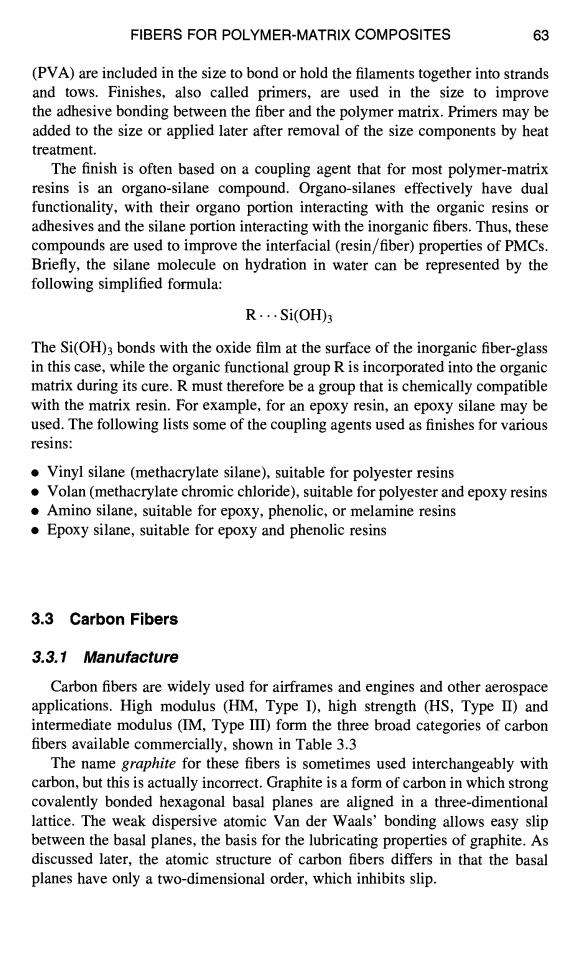正在加载图片...

FIBERS FOR POLYMER-MATRIX COMPOSITES 63 (PVA)are included in the size to bond or hold the filaments together into strands and tows.Finishes,also called primers,are used in the size to improve the adhesive bonding between the fiber and the polymer matrix.Primers may be added to the size or applied later after removal of the size components by heat treatment. The finish is often based on a coupling agent that for most polymer-matrix resins is an organo-silane compound.Organo-silanes effectively have dual functionality,with their organo portion interacting with the organic resins or adhesives and the silane portion interacting with the inorganic fibers.Thus,these compounds are used to improve the interfacial(resin/fiber)properties of PMCs. Briefly,the silane molecule on hydration in water can be represented by the following simplified formula: R...Si(OH) The Si(OH)3 bonds with the oxide film at the surface of the inorganic fiber-glass in this case,while the organic functional group R is incorporated into the organic matrix during its cure.R must therefore be a group that is chemically compatible with the matrix resin.For example,for an epoxy resin,an epoxy silane may be used.The following lists some of the coupling agents used as finishes for various resins: Vinyl silane (methacrylate silane),suitable for polyester resins .Volan(methacrylate chromic chloride),suitable for polyester and epoxy resins .Amino silane,suitable for epoxy,phenolic,or melamine resins Epoxy silane,suitable for epoxy and phenolic resins 3.3 Carbon Fibers 3.3.1 Manufacture Carbon fibers are widely used for airframes and engines and other aerospace applications.High modulus (HM,Type I),high strength (HS,Type II)and intermediate modulus(IM,Type III)form the three broad categories of carbon fibers available commercially,shown in Table 3.3 The name graphite for these fibers is sometimes used interchangeably with carbon,but this is actually incorrect.Graphite is a form of carbon in which strong covalently bonded hexagonal basal planes are aligned in a three-dimentional lattice.The weak dispersive atomic Van der Waals'bonding allows easy slip between the basal planes,the basis for the lubricating properties of graphite.As discussed later,the atomic structure of carbon fibers differs in that the basal planes have only a two-dimensional order,which inhibits slip.FIBERS FOR POLYMER-MATRIX COMPOSITES 63 (PVA) are included in the size to bond or hold the filaments together into strands and tows. Finishes, also called primers, are used in the size to improve the adhesive bonding between the fiber and the polymer matrix. Primers may be added to the size or applied later after removal of the size components by heat treatment. The finish is often based on a coupling agent that for most polymer-matrix resins is an organo-silane compound. Organo-silanes effectively have dual functionality, with their organo portion interacting with the organic resins or adhesives and the silane portion interacting with the inorganic fibers. Thus, these compounds are used to improve the interfacial (resin/fiber) properties of PMCs. Briefly, the silane molecule on hydration in water can be represented by the following simplified formula: R... Si(OH)3 The Si(OH)3 bonds with the oxide film at the surface of the inorganic fiber-glass in this case, while the organic functional group R is incorporated into the organic matrix during its cure. R must therefore be a group that is chemically compatible with the matrix resin. For example, for an epoxy resin, an epoxy silane may be used. The following lists some of the coupling agents used as finishes for various resins: • Vinyl silane (methacrylate silane), suitable for polyester resins • Volan (methacrylate chromic chloride), suitable for polyester and epoxy resins • Amino silane, suitable for epoxy, phenolic, or melamine resins • Epoxy silane, suitable for epoxy and phenolic resins 3,3 Carbon Fibers 3.3.1 Manufacture Carbon fibers are widely used for airframes and engines and other aerospace applications. High modulus (HM, Type I), high strength (HS, Type II) and intermediate modulus (IM, Type III) form the three broad categories of carbon fibers available commercially, shown in Table 3.3 The name graphite for these fibers is sometimes used interchangeably with carbon, but this is actually incorrect. Graphite is a form of carbon in which strong covalently bonded hexagonal basal planes are aligned in a three-dimentional lattice. The weak dispersive atomic Van der Waals' bonding allows easy slip between the basal planes, the basis for the lubricating properties of graphite. As discussed later, the atomic structure of carbon fibers differs in that the basal planes have only a two-dimensional order, which inhibits slip